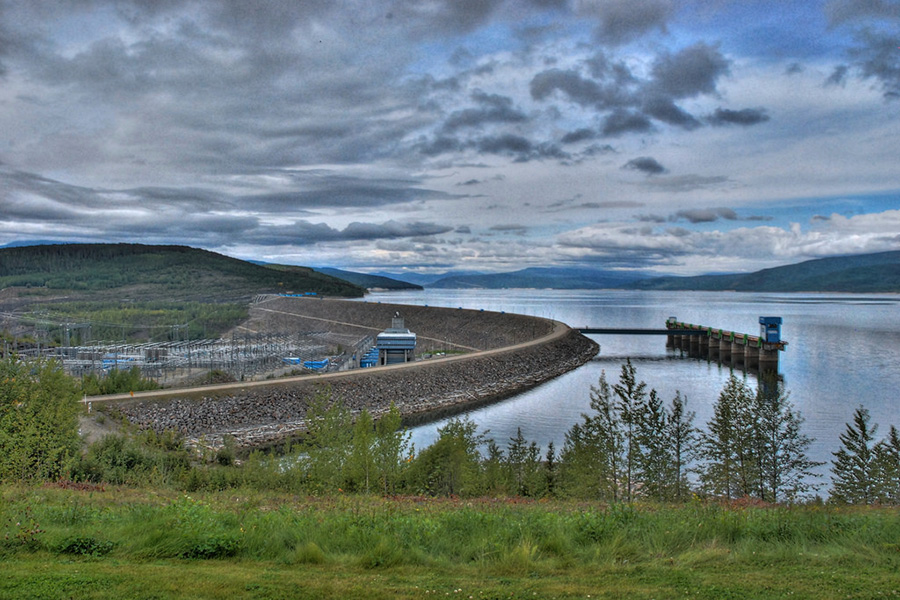BC Hydro is doing far less to ban potentially destructive fracking operations near its biggest dams than an Alberta power producer, raising questions about why British Columbia isn’t taking more action to protect public safety.
Documents obtained through a Freedom of Information request by the Canadian Centre for Policy Alternatives show that BC Hydro officials have feared for years that fracking-induced earthquakes could damage its dams and reservoirs. (Find yesterday’s report on those FOIs here.)
Senior dam safety officials with the Crown corporation even worried for a time that energy companies could drill and frack for gas directly below their Peace River dams. A dam failure could kill hundreds, if not thousands of people.
In an April 2012 email released in response to the FOI, BC Hydro’s director of dam safety, Stephen Rigbey, noted that the sale of drilling rights in the Montney gas field in the region meant “there may actually be a number of different owners laying claim under our damsites.”
Yet despite years of discussions with the BC Oil and Gas Commission, which regulates industry activities, BC Hydro has obtained only modest commitments to prevent fracking near its two Peace River dams — the massive W.A.C. Bennett Dam, which impounds the world’s seventh-largest reservoir, and the smaller downstream Peace Canyon Dam.
The restrictions, which Rigbey describes as “an understanding,” also apply to a third dam planned for the river, the controversial $9-billion Site C project.
Both BC Hydro and the commission say the understanding is that “no new tenures” will be issued to companies wishing to drill and frack for natural gas within five kilometres of BC Hydro’s dams.
However, companies who already hold rights would not be barred from fracking.
“If future activity related to the existing tenures is planned, we will work closely with the Oil and Gas Commission to put restrictions in place to effectively manage any risk,” Rigbey said in an email response to questions.
What those restrictions would be remains the subject of discussions.
While the dams have some protection, there are no restrictions on drilling and fracking around the massive reservoirs impounded by BC Hydro’s existing Peace River dams or the future Site C reservoir.
In an email response to questions, the Oil and Gas Commission said that at this time the Ministry of Natural Gas Development “is not accepting any new requests for subsurface rights within five kilometres of the Site C construction area.”
There are no active hydraulic fracturing operations within five kilometres of BC Hydro’s Peace River dams, the email said, but there are “a small amount of existing subsurface rights issued within the five kilometre buffer zone around Site C.”
The rights were issued before the buffer was created, the commission said. “Any applications in that area, or elsewhere, go through a strict review process before permits are issued,” the statement said. “The Commission is also talking with BC Hydro about any additional permit conditions that would be required to protect public safety and the environment in the area specifically, before construction occurs on Site C.”
Lagging behind Alberta
But B.C.’s measures fall short of the steps that Alberta electricity provider TransAlta has taken to protect its dams and reservoirs.
In interviews and correspondence, TransAlta revealed it has effectively shut down all fracking within five kilometres of one of its dams — and around the dam’s entire reservoir.
And TransAlta has succeeded in imposing restrictions on potentially destructive fracking operations up to 10 kilometres from its dam.
But, as in B.C., there is nothing in writing — no regulation or law — banning natural gas companies from fracking near sensitive infrastructure such as hydro dams and reservoirs.
“At this time there is no regulated/government mandated exclusion areas near critical infrastructure in Alberta,” says TransAlta spokesperson Stacey Hatcher. Rather, Hatcher says, an “agreement” has been reached to exclude some hydro dams and reservoirs from fracking zones.
Both provinces appear reluctant even to suggest that fracking is inappropriate in certain cases where public safety is concerned, perhaps fearing the precedent such an admission would represent.
BC Hydro’s modest achievements come as the BC Liberal government pursues two at times conflicting agendas.
On the one hand, Premier Christy Clark vows to push the Site C hydro dam, the most expensive infrastructure project in B.C.’s history, “past the point of no return.”
On the other, the government continues to push development of a liquefied natural plant near Prince Rupert by Malaysian state-owned Petronas and attack project critics. Should the plant be built, natural gas drilling and fracking near the Peace River and its hydro facilities would significantly ramp up to provide the needed natural gas.
In an April 2012 email, Rigbey likened potential fracking in the Peace to “carpet bombing,” adding that in future years much of the anticipated fracking would occur across a “well-established” regional stress regime.
With or without LNG, expect more fracking
Even if no LNG plants are built — an increasing likelihood given Shell’s announcement last month that it was delaying a decision on another plant — an upswing in natural gas prices would almost certainly bring increased gas drilling and fracking. That would include activity alongside the reservoir that would be created by the Site C dam, which would flood more than 100 kilometres of the Peace River and its tributaries.
Even without fracking, up to 4,000 landslides are expected to dump debris into the reservoir as a result of the Site C dam, according to documents filed by BC Hydro as part of a federal-provincial review of the project. The 676-page report makes no mention of additional risks should earthquakes be triggered nearby.

Martyn Brown, former chief of staff to Clark’s predecessor, Gordon Campbell, says the province’s conflicting agendas underscore a troubling aspect of oil and gas industry regulation in the province.
Brown says from its creation the Oil and Gas Commission has both promoted and regulated industry activities. Setting limits on where companies drill and frack is simply not part of commission’s culture, he says.
Brown says the commission — like the National Energy Board — is locked into an inherent conflict of interest.
“It has a dual role as a proponent of oil and gas development, but also its regulator,” Brown says. “And I think there is a fundamental conflict with that.”
Political oversight of the commission is also problematic. Natural Gas Development Minister Rich Coleman is responsible for the Oil and Gas Commission. As his title indicates, his mission is to “promote oil and gas activity,” not impose limits, notes Brown.
Brown said a neutral ministry — not responsible for promoting oil and gas development — should decide what activities will be allowed or barred if there are concerns oil and gas activities could threaten critically important public infrastructure like dams and reservoirs and public safety.
“Clearly what you need now is an independent voice in cabinet, the environment minister, to make broad determinations in an independent way,” Brown said. “The promoter should not be the regulator of oil and gas activities.”
Documents released in response to the FOI request show hydro-power producers in both Alberta and British Columbia have become increasingly alarmed at natural gas company activity on lands near their dams. The concerns have escalated as clusters of earthquakes have occurred in lockstep with fracking operations.
In one email released under the FOI request, Rigbey notes there are no regulations to stop oil and gas companies “from injecting into a pre-existing fault” in the rock. This creates the risk of fracking in geologically unstable areas, triggering or setting the stage for earthquakes.
While gas companies might not want to tap into such faults, Rigbey noted, “accidents can happen.”
In its public pronouncements, BC Hydro has been more muted in its concerns. In a 551-page report filed with the joint federal-provincial panel that reviewed the Site C project, BC Hydro devoted less than two pages to discussing “petroleum industry-related” earthquakes and downplayed the threat.
“The Oil and Gas Commission is now establishing procedures and requirements for monitoring and reporting of induced seismicity,” BC Hydro reported to the panel in January 2013. “Each case of induced seismicity will be evaluated on the basis of its unique site-specific characteristics, but it is proposed that hydraulic fracturing would be suspended upon detection of an earthquake of magnitude 4 or larger. It should be noted that earthquakes less than about magnitude 5 do not release enough energy to cause damage to engineered structures.”
In response to written questions, the Oil and Gas Commission said that as a result of discussions with BC Hydro the province “has established a five kilometre buffer area around the W.A.C. Bennett, Peace Canyon and Site C dams.”
Graham Currie, the commission’s executive director of corporate affairs, added that the Site C dam location is within the Montney Basin, which contains large quantities of shale gas. Gas from dense shale rock formations can only be coaxed from the earth by extensive use of fracking.
Gail Atkinson, an expert on induced earthquakes and a professor in earth sciences at the University of Western Ontario, says induced earthquakes can be hazardous because they occur much closer to the Earth’s surface than natural earthquakes. If such events happen near dams or other surface structures, the ensuing shaking can be much worse than from a naturally occurring earthquake of the same magnitude.
The higher the number of fracking-induced earthquakes near dams, the greater the risk that one of them might be strong enough to exceed a dam’s design and engineering limits.
“If the frequency of experiencing earthquakes near a dam increases, then the level of expected ground motions at the one per cent in 100 year likelihood level will increase,” Atkinson said. She warns that the risk will be greatest “in areas where the hazard was initially low because there is little natural seismicity.”
Atkinson added that even earthquakes of “moderate” strength could damage dams or other structures if they are induced close to such structures.
BC Hydro doesn’t talk about these risks publicly. In an online video on dam safety, for example, Rigbey talks about the threats to dams from naturally occurring earthquakes but doesn’t mention fracking or the increasing number of tremors associated with it.
Atkinson’s work has clearly influenced TransAlta’s thinking. The company is one of three organizations that fund her research chair on hazards associated with induced earthquakes. (The other two are the National Sciences and Engineering Research Council and Nanometrics, a maker of seismic monitoring equipment.)
TransAlta also covers costs so some of its engineers and dam safety officials can be part of a multidisciplinary research effort known as the Canadian Induced Seismicity Collaboration.
The CISC’s website notes that fracking-induced earthquakes are a “pressing problem” in Western Canada, and in British Columbia and Alberta particularly. “There is a significant (though very small) possibility that triggered events could be large enough to cause significant damage,” the CISC’s scientists say.
TransAlta’s Hatcher says the company has secured agreements with natural gas companies operating in Alberta to limit drilling and fracking near the Brazeau dam and its 13-kilometre long reservoir.
The special “traffic light” system applies to a zone between five kilometres and 10 kilometres from the dam and reservoir, she said in a written response to questions. “The traffic light system works in a similar manner to other traffic light systems for hydraulic fracturing, with a green (proceed), yellow (pause and monitor) and red (stop) protocol,” Hatcher said.
“TransAlta is concerned about the potential impact of fracking-induced earthquakes and continues to work with the Alberta Energy Regulator, Alberta Environment and the oil and gas operators to ensure that hydrocarbon development occurs in a safe manner that doesn’t create unnecessary risk to existing infrastructure,” Hatcher added.
TransAlta has effectively shut down fracking in the most sensitive zone extending five kilometres from the dam and reservoir after filing a number of “statements of concern” with the Alberta Energy Regulator, that province’s equivalent of the Oil and Gas Commission.
Hatcher said that TransAlta could not release documents related to the agreements and referred questions to the AER. The Canadian Centre for Policy Alternatives has filed a second Freedom of Information request to obtain relevant documents.
Documents released by BC Hydro show the Crown corporation was prompted to call for frack-free buffer zones around its dams after learning what TransAlta had achieved in Alberta.
Giant underground gas reservoirs and fracking
Only one other highly sensitive — yet little known — infrastructure project in B.C. is currently the subject of special operating guidelines covering fracking. BC Hydro learned of those guidelines in email correspondence with the Oil and Gas Commission.
The project is a massive underground storage reservoir capable of holding approximately 2.3 billion cubic metres of natural gas. It is near an area called Pink Mountain, northwest of Fort St. John, where Progress Energy, a subsidiary of Petronas, is building roads, well pads, freshwater and wastewater holdings ponds, compressor stations, pipeline corridors and other infrastructure integral to the drilling and fracking process.
The company also has plans, which the provincial government has exempted from BC Utilities Commission review, for a privately owned and operated hydro transmission line from the Peace River’s hydroelectric facilities. The new line would allow Progress to burn less natural gas by switching to hydroelectricity, thus increasing the profitability of its fracked gas.
The gas storage facility consists of two underground reservoirs about 1,400 metres below the surfaces. Since the late 1980s, natural gas has typically been pumped into the reservoirs in the summer when gas demand is low and then pumped out as needed in the fall and winter.
Fortis Inc. announced that it was purchasing the facility from Chevron in 2015 for about US$266 million.
Fortis noted then that the facility could become critical in the event LNG went ahead in the province. “The facility — which is the only underground gas storage facility in B.C. offering storage to third parties — is also uniquely positioned to benefit from the completion of proposed LNG export projects, where it could provide balancing services to suppliers and LNG exporters.”
In an email response to questions, David Bennett, Fortis BC’s director of communications and external relations, said that “successful meetings” were held between the company, the Oil and Gas Commission and the Ministry of Natural Gas Development.
Those talks resulted in new rules that “ensure current and future drillers and well operators are aware of the facility and operate in such a manner to maintain the integrity of the underground storage reservoirs and ensure that new well production is not taken from the ACGS [Aitken Creek Gas Storage] reservoirs.”
In a followup phone interview, Bennett said that Fortis had no fears that fracking into the reservoir could result in a cataclysmic event like an explosion.
The main concern, he said, is to avoid someone taking gas out of the reservoirs by fracking into them. “We don’t want anyone interfering with the reservoir,” he said, adding Fortis wants Progress Energy and any other companies engaged in fracking “to stay away from the reservoir.”
Documents released through the FOI request show that the commission has established “conditions for permits” for companies operating near the gas reservoirs. The conditions do not include an outright ban on fracking or gas drilling. On maps supplied by the Oil and Gas Commission, the buffer area is irregularly shaped and in most cases extends less than five kilometres from the reservoirs.
In email correspondence, the Oil and Gas Commission said any company holding a permit to drill and frack for gas near the reservoirs “must not conduct any drilling completions or well operations” that have “a material adverse impact on the integrity or safe operation” of the facilities.
How this is monitored and enforced is not clear.
Natural gas companies operating in the zone are also required to notify Fortis when a well is about to be drilled and fracked. They must also notify the company when they resume drilling following “a temporary suspension” of operations.
The special permit conditions do not specify what would lead to a “temporary suspension.” But earthquakes induced by fracking are among the events that have triggered stoppages in previous fracking operations.
Like the arrangements that have been worked out with BC Hydro, the special operating conditions at Aitken Creek are not common knowledge. Neither the commission nor the provincial government has issued a press release stating that special permit conditions, such as they are, are in place in the Aitken Creek area.
Much like the silence surrounding buffer zones around B.C.’s biggest hydroelectric dams, the government seems to be of the view that the less said, the better. ![]()
Read more: Energy, BC Politics, Environment
















Tyee Commenting Guidelines
Comments that violate guidelines risk being deleted, and violations may result in a temporary or permanent user ban. Maintain the spirit of good conversation to stay in the discussion.
*Please note The Tyee is not a forum for spreading misinformation about COVID-19, denying its existence or minimizing its risk to public health.
Do:
Do not: